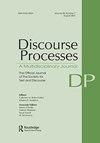Vocabulary size and exposure to print predict mastery of connectives in teenage years
IF 2.1
2区 心理学
Q2 PSYCHOLOGY, EDUCATIONAL
引用次数: 0
Abstract
Connectives such as because and but are crucial for signaling coherence relations in discourse. They contribute to a better reading comprehension and, thus, academic performance. The aim of this article is to contribute to our understanding of connective development during teenage years by studying individual differences in the performance of native Russian-speaking teenagers (N = 107, Mage = 13.93, range: 11 to 17) in a connective-cloze task. The tested connectives marked six coherence relations and were used either predominantly in speech or in the written language. In addition, we examined whether students’ performance with the connectives was modulated by their general linguistic experience, as assessed by a vocabulary test and degree of exposure to print. Our results reveal that interpersonal differences in lexicon size and level of exposure to print were the strongest predictors of appropriate usage of connectives, whereas differences in age, connective mode, and polyfunctionality played a lesser role. This finding may indicate that, starting from age 11, biological age and intrinsic properties of connectives matter less for their mastery than general linguistic experience, as measured by vocabulary level and exposure to print.词汇量的大小和接触印刷品的时间可以预测青少年对连接词的掌握程度
because和but等连接词是语篇中表达连贯关系的关键。它们有助于更好的阅读理解,从而提高学习成绩。本文的目的是通过研究母语为俄语的青少年(N = 107, Mage = 13.93,范围:11 - 17)在连接填空任务中的个体差异,帮助我们理解青少年时期的连接发展。测试的连接词标记了六种连贯关系,主要用于口头或书面语言。此外,我们通过词汇测试和接触印刷品的程度来评估学生使用连接词的表现是否受到他们的一般语言经验的调节。我们的研究结果表明,词汇量和印刷品接触水平的人际差异是正确使用连接词的最强预测因子,而年龄、连接方式和多功能性的差异则起着较小的作用。这一发现可能表明,从11岁开始,生物年龄和连接词的内在属性对他们掌握的影响不如一般的语言经验,这是通过词汇水平和接触印刷品来衡量的。
本文章由计算机程序翻译,如有差异,请以英文原文为准。
求助全文
约1分钟内获得全文
求助全文
来源期刊

Discourse Processes
Multiple-
CiteScore
4.30
自引率
4.50%
发文量
27
期刊介绍:
Discourse Processes is a multidisciplinary journal providing a forum for cross-fertilization of ideas from diverse disciplines sharing a common interest in discourse--prose comprehension and recall, dialogue analysis, text grammar construction, computer simulation of natural language, cross-cultural comparisons of communicative competence, or related topics. The problems posed by multisentence contexts and the methods required to investigate them, although not always unique to discourse, are sufficiently distinct so as to require an organized mode of scientific interaction made possible through the journal.
 求助内容:
求助内容: 应助结果提醒方式:
应助结果提醒方式:


